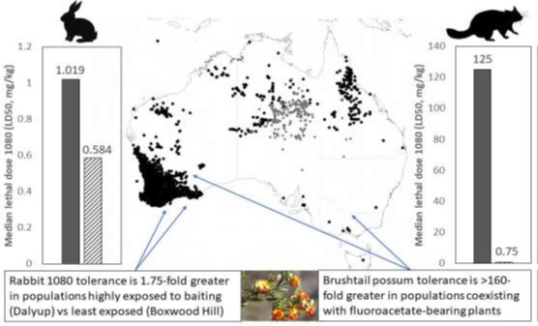Improving Introduced Predator Management
Poison 1080 baits are laid over millions of hectares each year to control these pests. 1080 contains fluoroacetate, a natural plant toxin found in some native Australian plants. Native wildlife vary considerably in their tolerance to 1080 depending on evolutionary exposure (e.g. brushtail possums across the continent show marked differences in resistance to 1080; Fig. 1), but introduced pest species are highly sensitive as they did not evolve in Australia.

Fig 1: The distribution of Gastrolobium (black dots) and Acacia (grey dots) plants with fluoroacetate (Leong et al. 2017). Rabbit 1080 tolerance is greater with long history of baiting or high bait exposure (Twigg et al. 2002). Native fauna show a gradient of tolerance matching toxic plant distribution (Eason et al. 2011).
This project has relevance for conservation management and agriculture across the country. Results will help ensure plant toxins can be used safely and humanely by farmers and land managers to control pests into the future for the protection of livestock and wildlife.
This PhD project suits a student interested in applied wildlife biology. The student will be based at Murdoch University.
This project will contribute to an Australian Research Council (ARC) Discovery Project addressing knowledge gaps about whether pest species are becoming bait resistant in areas where baiting has been carried out over several decades. This Discovery Project will contribute to understanding of whether there is learned aversion to baits, or whether there could be increasingly physiological resistance to the toxin (as has been shown in baited populations of rabbits; Fig. 1). This PhD project will focus on aspects of the project including studies of the behavioural (1080 detection, bait avoidance/shyness) and morphological (e.g. increase in body size, changes in demographics) responses of cats and foxes at sites across Australia (west to east) and at sites with and without long term 1080 poison control.
Eligibility
Applicants must be full time and meet the admission requirements of the required HDR degree to be eligible (first or upper second-class Honours degree, Masters degree by research, or equivalent)
Scholarship duration 3.5 years